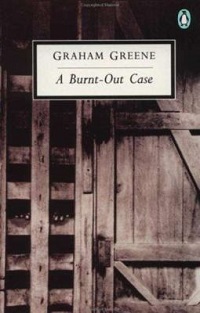
Of all the books I have read by Graham Greene – who was an amazingly prolific writer, often regarded as one of the leading English novelists of the 20th century — I have found A Burnt-Out Case the most poignant. It is about a world-famous architect, Querry, who is “burnt out” emotionally and ends up in a leper colony in Africa, in an attempt to get as far away from his life as he can. I first read this book when I was younger, and it greatly resonated with me at that time because I was also trained as an architect. I recently read it again and found that it is now relatable to any older person going through a mid-life crisis and questioning the worth of anything they have accomplished in their lives. Either way, it is an excellent book, amazingly well-written.
We don’t hear much of leprosy anymore, but at the time the book was written, the disease was much more common with millions of people infected, mostly in poor countries. This was also a time when Christian missionaries were very active, and one of their many charitable works was creating and running leper colonies, where lepers could be treated. Because of the social stigma associated with leprosy, these colonies were typically located in remote and isolated regions, far from cities and towns, and it is to one such colony in Africa that the disillusioned Querry arrives, trying to get as far away from his life in Europe as a plane and then a boat would take him. The term “burnt-out case” has a very specific meaning in leprosy – it refers to leprosy patients who have been cured but have suffered severe mutilations in the course of repeated infections, losing most of their extremities like fingers, toes, nose, etc., rendering them barely recognizable to themselves and to others. The doctor who runs the leprosy clinic diagnoses Querry as being a “burnt-out case” as well; only in Querry’s case the disease is in his mind rather than in his body. He simply can’t feel any emotion anymore, neither joy, nor sorrow, neither pleasure, nor pain.
A Burnt-Out Case is the story of Querry’s time in the leper colony and of his interactions with the people there. There is the doctor, who has his hands full with patients and works tirelessly from morning to night; also, he is a confirmed atheist and is there for no other reason than to use his skills to alleviate pain and suffering. There are the Catholic missionaries who have set up the colony, and who find themselves mostly concerned with the physical well-being of the patients rather than their spiritual upliftment; they have to make sure to keep the hospital facility running, which means they are preoccupied with thinking of things like generators, plumbing, roofing, and so on. And then there are the patients themselves, in particular, the boy assigned to be a helper to Querry, who happens to be an actual “burnt-out case” himself and is severely mutilated.
In the course of time, interacting with all these people and being away from the wealth, fame, and success that had destroyed his “soul,” Querry seems to achieve some measure of peace from the demons that plague him. He even eventually agrees to use his architectural stills to design a functional structure for an extension to the clinic and sets up a drawing board in his room. Sadly however, just when he is starting to heal, starting to feel some emotions, his past life and fame catch up with him. He had tried very hard to stay completely anonymous so he could be left alone, but he is discovered, and the consequences are disastrous.
In addition to being so well written, I found the book so detailed and so vivid that I felt I was actually there at the leper colony, seeing the story unfold before my eyes. Of course, this is in large measure due to the author’s extraordinary talent as a novelist, but I also found out that he had actually visited a number of leper colonies in the course of his extensive travels, which had inspired the book and made it so authentic. We are so fortunate to have authors like this who have traveled to different parts of the world, writing books that viscerally take us to places we would never have a chance to visit, at a different time, and have experiences we would never have in our own lives.
The only quibble I had with the story is that it builds up the myth of the architect as a “creative genius,” somewhat similar to Ayn Rand’s The Fountainhead. While such books are very inspiring, almost heady, to young architects, they are sending the wrong message that architecture is a solitary vocation, when, in fact, it is much more of a collaborative effort than a writer or an artist. A real-life Querry would not be so “burnt-out” because he would be working with a team of people on his architectural designs rather than being completely on his own, and it is much harder to get disillusioned when you are working with others.
A Burnt-Out Case
Author: Graham Greene
Original Publisher and Date: Heinemann, 1950
Reprint Publisher and Date: Penguin Classics, April 1992
Contributor: Lachmi Khemlani runs a technology publication in the San Francisco Bay Area.